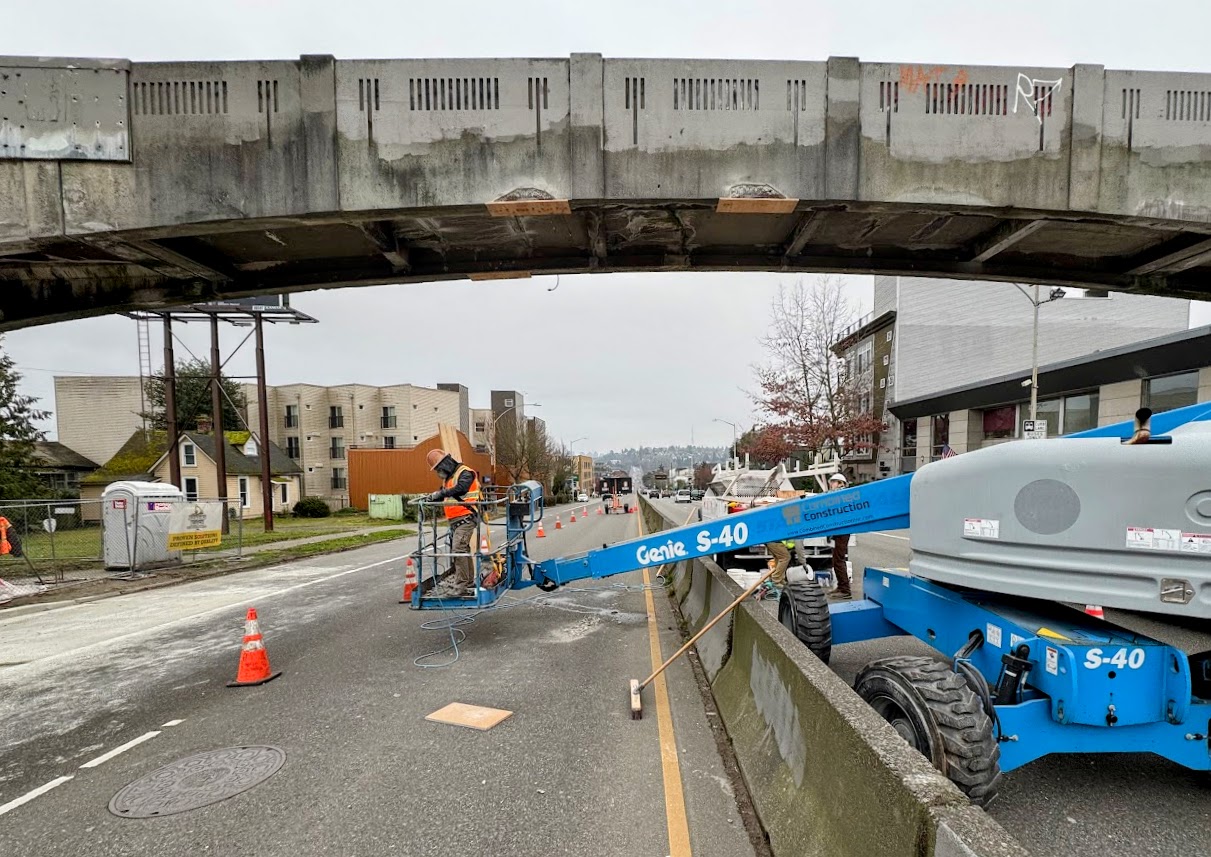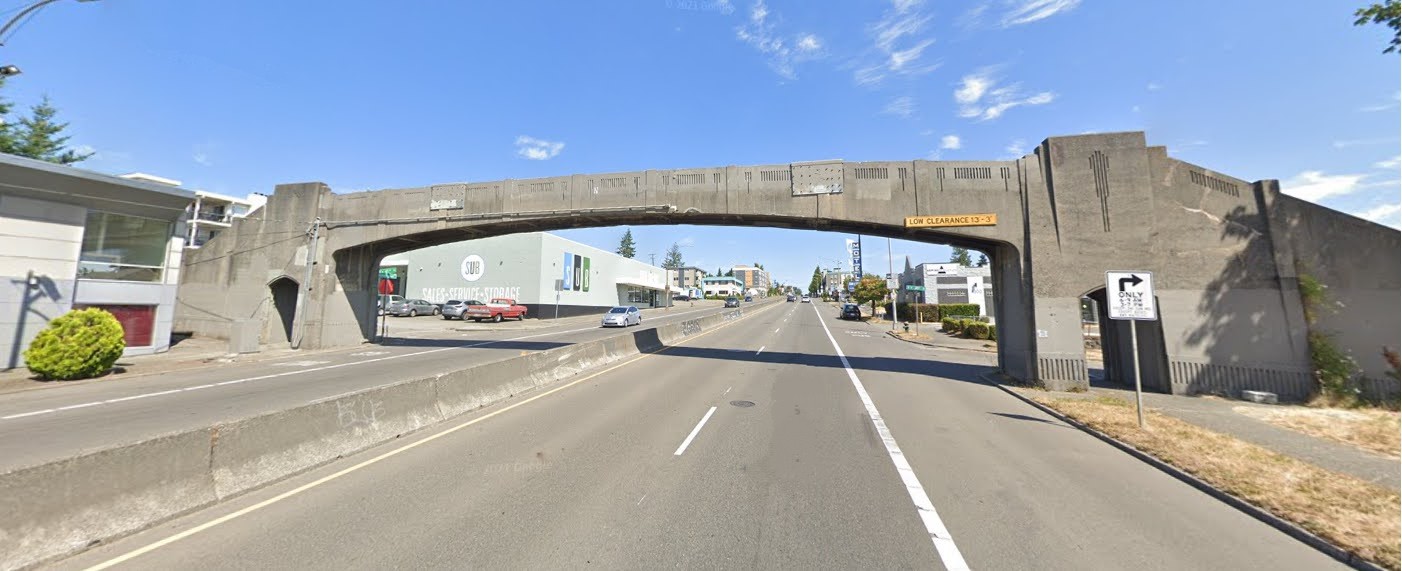Today the defined area of the Fremont neighborhood is bounded by 50th Street on the north, and Stone Way on the east. Fremont started in 1888 as a convenient streetcar neighborhood. Little stores sprang up at intersections of streetcar stops and transfer points, like this one at 4900 Stone Way.
Over time these streets have been expanded for car traffic and now are largely commercial areas. Today there is a Bamboo Village restaurant at this address, with a parking lot to accommodate cars.
A Fremont investment in 1888
From its earliest years, Seattle attracted investors in business, real estate and timber. Some investors came for a look around, fell in love with Seattle and never left. Others came and made investments but then went back home. Edward & Carrie Blewett of Fremont, Nebraska, came to make land investments in Seattle and they gave the name of Fremont to a suburb-like development which was outside of the Seattle City Limits at that time.
In that year of 1888 when Fremont came into existence, another investor, Theophilus J. Porterfield, came from Minneapolis, Minnesota, to survey the opportunities in the Seattle area. Mr. Porterfield was a “timberman” who had lived in Wisconsin, Michigan and Minnesota. During his visit to Washington Territory in 1888-1889 he invested in some timber property in Snohomish County.
In December 1888 Mr. Portfield filed a plat map for land he’d purchased in the northeast corner of Fremont, between North 45th to 50th Streets. The property was bounded on the west side by Woodland Park Avenue where Fremont’s backers were in process of laying out a streetcar line to reach Guy Phinney’s picnic grounds and private zoo.
Mr. Porterfield brought his wife Elizabeth and daughter Wilhelmina Louise with him to Seattle, and the family stayed at a hotel in Belltown, at First & Battery Streets. It appears that during their sojourn in Seattle the teenage Mina met and fell in love with Samuel Hauser, who worked at the Hauser family’s building contractors company. Samuel Hauser had been brought to Seattle as child in the 1870s. His father had worked as a carpenter and then advanced to own a builders contracting business.
The Porterfield family went back to Minneapolis, and as soon as Mina turned 18, in 1891 Samuel Hauser went to Minnesota and they were married. After their marriage, Samuel & Mina stayed in Minneapolis for several more years, perhaps in deference to Mina’s mother who was probably loathe to lose her only daughter.
Seattle continues to attract investors in the 1900s
By the year 1900 major timbermen of the Minneapolis-St. Paul area were closing operations and moving to the Pacific Northwest in search of a fresh supply of trees. In January 1900 newspapers were full of the story of a blockbuster land sale from railroad magnate James J. Hill to timber industry leader Frederick Weyerhaeuser. Weyerhaeuser moved his lumber operations to the Pacific Northwest, as did the Laird-Norton Company of Minnesota.
Perhaps these tales of timber riches were on the mind of Theophilus Porterfield when he suddenly turned up in Seattle in November 1906. He consulted a Seattle attorney, David McVay, to represent him as administrator of his property, the Porterfield’s Addition, a plat in Fremont. Mr. Porterfield claimed that his son-in-law, Samuel Hauser, had appropriated the property and wouldn’t give it back to him.
Mr. Porterfield, who was now 79 years old, had made the long journey by himself from Minneapolis to Seattle by train and had caught cold on the way. Suddenly on November 30th he collapsed and died while visiting a friend on Seattle’s Capitol Hill. Fortunately, the attorney, David McVay, had Mr. Porterfield’s background info and was able to contact Mrs. Porterfield in Minneapolis.
The attorney’s search of property records showed that there never had been a transaction giving the Fremont property to Samuel Hauser, Porterfield’s son-in-law. Over time, all the lots in the Porterfield plat in Fremont had already been sold, before Mr. Porterfield’s return visit to Seattle in 1906. Perhaps when the money stopped coming in, Mr. Porterfield became confused and thought there was some fraud.
The Seattle newspapers had printed the “fraud” story which Mr. Porterfield had told his contacts in Seattle. The newspaper then had to print a retraction, because Samuel Hauser wrote to the newspaper to deny any wrongdoing. He said that he wanted to clear his family’s name, as many of the Hausers still lived in Seattle.
Today the Porterfield’s Addition in the northeast corner of Fremont still has many old houses, like 1109 North 47th Street. This area of Fremont is still considered to be very convenient, but now it is because of access to major roadways of car travel like 50th & Stone Way, instead of streetcars.
Sources:
Genealogy resources including census, newspaper search and Find A Grave which includes biographical information: Theophilus Porterfield.
HistoryLink Essay #8115, “James J. Hill,” by Paula Becker, 2007.
HistoryLink Essay #7295, “Norton Clapp,” by Cassandra Tate, 2005.
HistoryLink Essay #3285, “Woodland Park Railway begins running in 1890 (Guy Phinney),” by Greg Lange, 2001.
Laird Norton company history.
“Minneapolis Man Expires Suddenly,” Seattle Post-Intelligencer, December 1, 1906, page 3.


